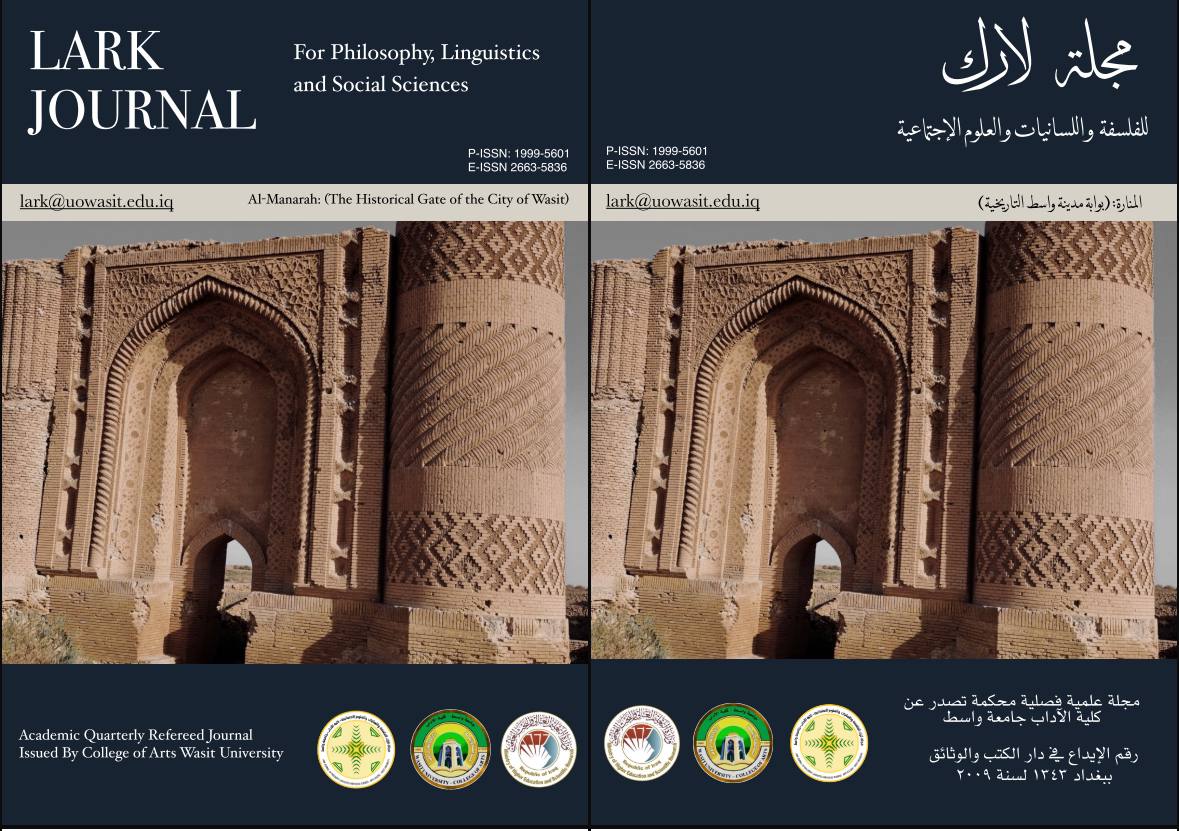مقدمة المترجم كنص موازٍ: دراسة موضوعية لمقدمات المترجم في الترجمات من الإنجليزية إلى العربية
DOI:
https://doi.org/10.31185/lark.4812الكلمات المفتاحية:
الكلمات المفتاحية: النصوص الموازية، مقدمة المترجم، التحليل الموضوعي.الملخص
ستكشف هذه الدراسة مقدمة المترجم كعنصر أساسي في الترجمة من الإنجليزية إلى العربية. واستنادًا إلى نظرية جينيت (1997) للنصوص الموازية وتركيز باتشلور (2018) على التعامل مع النصوص الموازية كغايات في حد ذاتها، تُجري الدراسة تحليلًا موضوعيًا على (50) مقدمة للمترجمين تم اختيارها عشوائيًا لدراسة أنماطها الموضوعية وخصائصها الوظيفية. وتُستخدم منهجية مختلطة، تجمع بين التحليل الموضوعي النوعي وتحليل التكرار الكمي لتحديد الموضوعات المتكررة والأكثر شيوعًا التي ناقشها المترجمون في مقدماتهم. وتُقدم الدراسة نموذج وادي والعلي (2025) كنموذج مقترح يمكن تطبيقه في الدراسات المستقبلية لتقييم مقدمات المترجمين في سياقات مختلفة.
المراجع
Alblooshi, F. K. (2021). The role of paratextual elements in the reception of translation of Arabic novels into English (Doctoral dissertation, Kent State University). OhioLINK Electronic Theses and Dissertations Center. http://rave.ohiolink.edu/etdc/view?acc_num=kent1617719565200925
Ashraf, M. (2020). Paratextual Aspects in the Translation of Nawal Saadawi’s The Innocence of the Devil.
Batchelor, K. (2018). Translation and paratexts. Routledge. https://doi.org/10.4324/9781351110112
Braun, V., & Clarke, V. (2006). Using thematic analysis in psychology. Qualitative Research in Psychology, 3(2), 77–101. https://doi.org/10.1191/1478088706qp063oa
Dimitriu, R. (2009). Translators’ prefaces as documentary sources for translation studies. Perspectives: Studies in Translatology, 17(3), 193-206. https://doi.org/10.1080/09076760903255304
Fayed, S. (2021). Translators’ prefaces to literary works a means to visibility or invisibility? A cda approach to analyze translators’ prefaces as part of the paratext. Cairo Studies in English, 2020(1), 258–279. https://doi.org/10.21608/cse.2021.147203
Forbes, M. B. (2023). "To the General Reader:" How 16th-century paratexts evolved the reader (Publication No. 30485452) [Doctoral dissertation, Fordham University]. ProQuest Dissertations & Theses Global. https://www.proquest.com/openview/ccaa11e388b9d59e55176bc6540f9677/1?pq-origsite=gscholar&cbl=18750&diss=y
Freeth, P. J. (2023). Between consciously crafted and the vastness of context: Collateral paratextuality and its implications for translation studies. Translation Studies, 16(3), 419–435. https://doi.org/10.1080/14781700.2023.2194882
Genette, G. (1997). Paratexts: Thresholds of interpretation (J. E. Lewin, Trans.). Cambridge University Press.
Haroon, H. (2017). The translator’s preface as a paratextual device in Malay-English literary translations. The International Journal of Translation and Interpreting Research, 9(2). https://doi.org/10.12807/ti.109202.2017.a07
McRae, E. (2006). The role of translators’ prefaces to contemporary literary translations into English (Master’s dissertation, University of Auckland).
Nelson, K. (1998). A pretext for writing: Prologues, epilogues, and the notion of paratext. SSRN Electronic Journal. https://doi.org/10.2139/ssrn.1141062
Özbir, U. (2020). Translator’s preface and notes in the Turkish version of Pale Fire: Para-textual interventions of the translator justified? RumeliDE Dil ve Edebiyat Araştırmaları Dergisi, 18, 627–638. https://doi.org/10.29000/rumelide.706428
O’Connor, A. (2022). Women translators and paratextual authority: The frameworks of religious translation. Parallèles, 34, 130–140. https://doi.org/10.17462/para.2022.01.11
Pellatt, V. (Ed.). (2013). Text, extratext, metatext and paratext in translation. Cambridge Scholars Publishing.
Qun-Xing, Z. (2016). Translators’ Voice in Translated Texts. Journal of Literature and Art Studies, February 2016, Vol. 6, No. 2, 178-185 doi: 10.17265/2159-5836/2016.02.007
Rockenberger, A. (2014). Video game framings. In N. Desrochers & D. Apollon (Eds.), Examining paratextual theory and its applications in digital culture (pp. 252–286). IGI Global. https://doi.org/10.4018/978-1-4666-6002-1.ch013
Shakir, M.F. and Al-Ali, K. K (2021). Post-Editing as a Creative Tool in Improving the Quality of the Product of Translation Students. Journal of the College of Arts, University of Basrah. No. (97). V1. https://www.basradab.edu.iq/wp-content/uploads/2024/09/14_Post_Editing_as_a_Creative_Tool_in_Improving_the_Quality_of_the.pdf
Stokem, R. (2020). “This is a true story”: Paratextual prefaces and their fictive truths across literature (Master's thesis). Seton Hall University. Retrieved from https://scholarship.shu.edu/dissertations/2766
Tekten, B. (2019). A comparative study on the paratextual elements in the translations of Edgar Allan Poe’s short story compilations (Master’s thesis, Hacettepe University). Hacettepe University Graduate School of Social Sciences.
Terenas, G. G. (2023). Paratexts as mediators of translations. The case of the preface to a Portuguese version of Defoe’s Robinson Crusoe. Diacrítica, 37(3), 174–185. https://doi.org/10.21814/diacritica.4851
Toledano-Buendía, M. C. (2013). Listening to the voice of the translator: A description of translator’s notes as paratextual elements. The International Journal of Translation and Interpreting Research, 5(2). https://doi.org/10.12807/ti.105202.2013.a09
Venuti, L. (1995). The translator’s invisibility: A history of translation. Routledge.
Yalsharzeh, R., Barati, H., & Hesabi, A. (2019). Dissenting voices: When paratexts clash with texts. Paratextual intervention in persian translations of texts relating to the iran-iraq war. Meta, 64(1), 103–124. https://doi.org/10.7202/1065330ar
Yari, A., & Amirian, Z. (2022). Gender and paratextual visibility: A case study of Iranian fiction translators. Journal of Language Horizons, 6(3), 49–63. https://doi.org/10.22051/lghor.2021.34800.1434
التنزيلات
منشور
إصدار
القسم
الرخصة
الحقوق الفكرية (c) 2025 أ. د. كاظم خلف العلي، الباحثة: رغد سعدون وادي

هذا العمل مرخص بموجب Creative Commons Attribution 4.0 International License.





